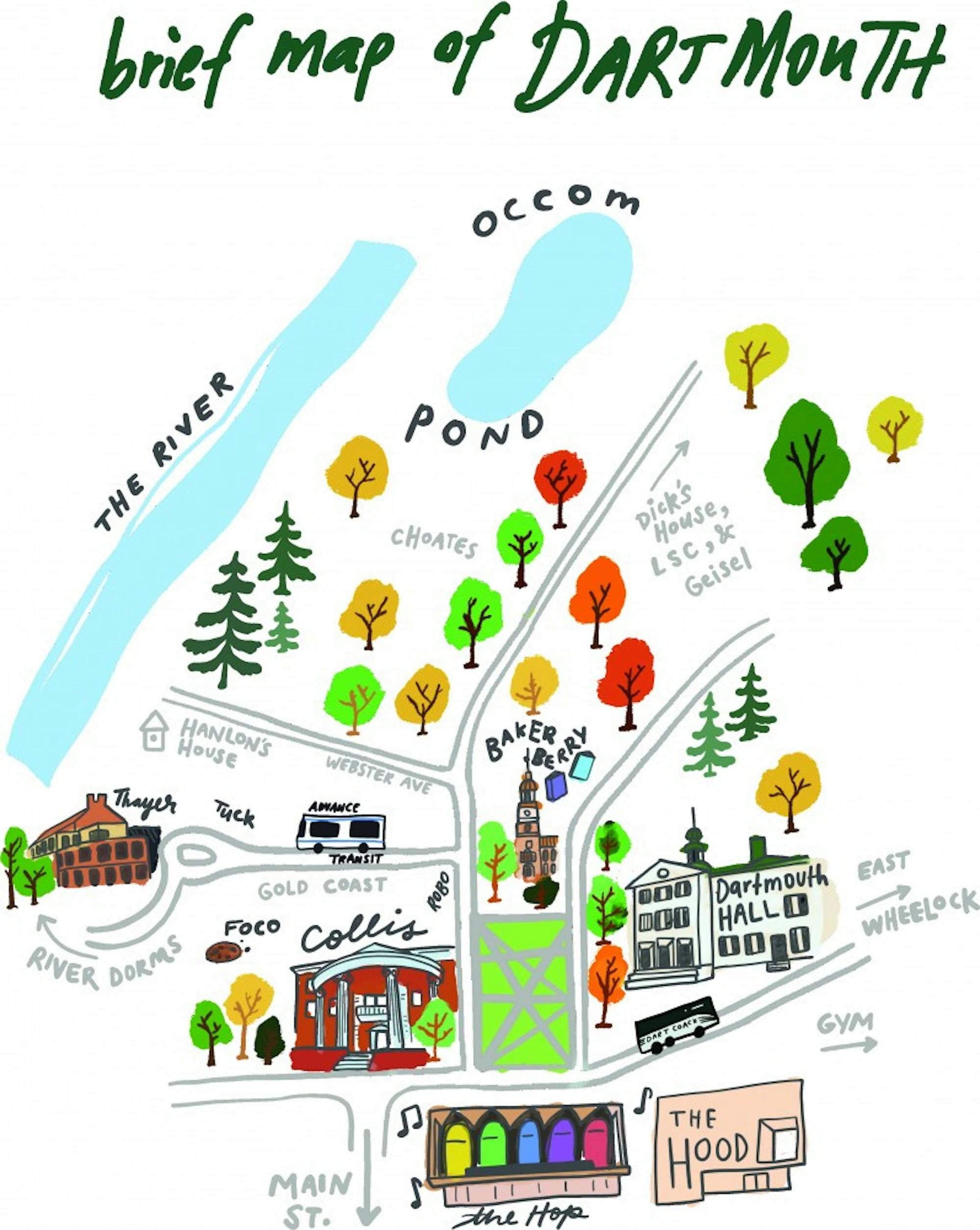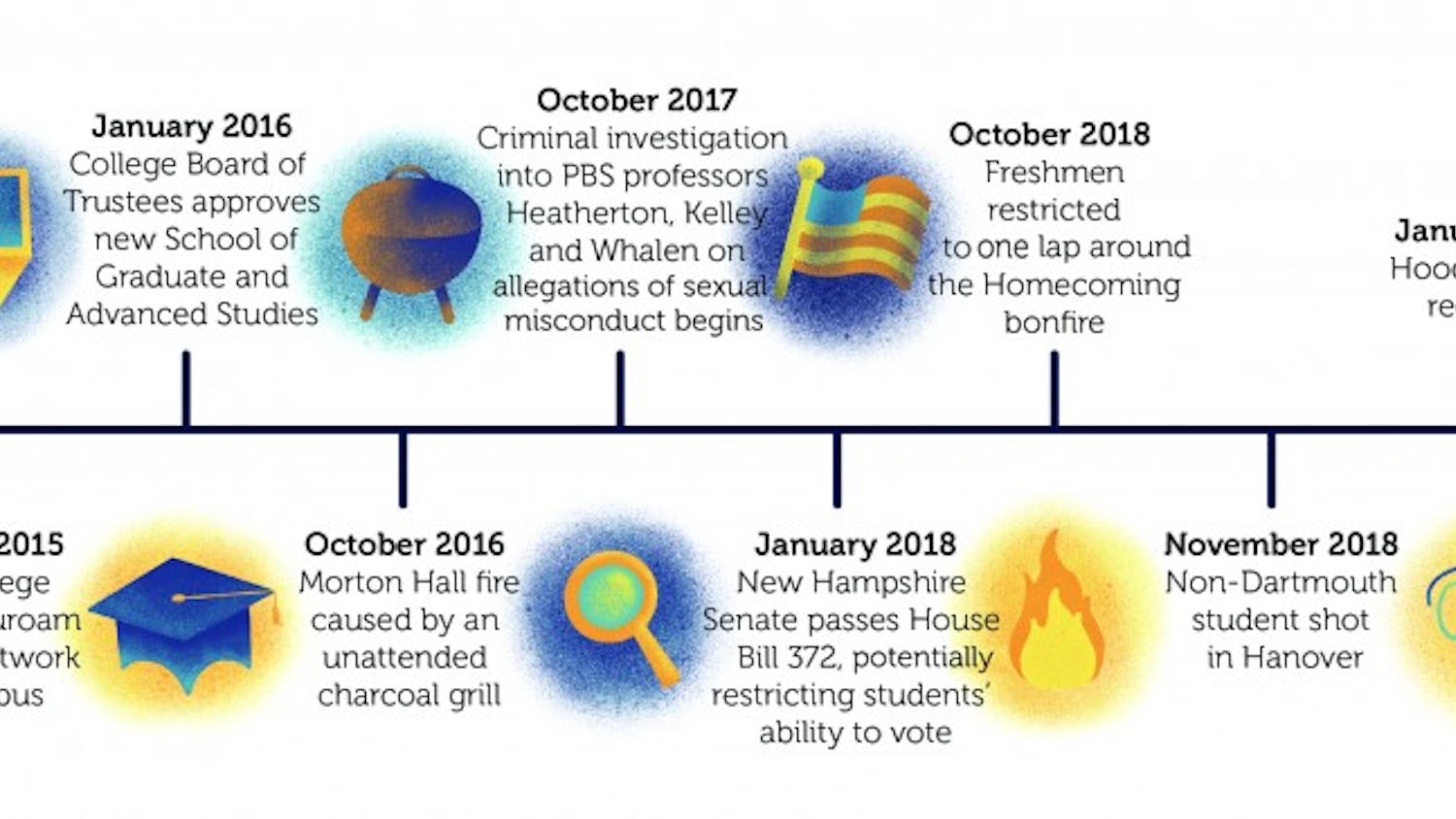Whether it’s your freshman dorm, a bench on the Green or a library study nook, you will soon find a place at Dartmouth that you connect to. But first, you will get lost more times than you can count, even after you ask five upperclassmen for directions. Here’s to minimizing your confusion and providing basic details about the most important campus locations to know! The locations are in approximate order of North to South.
Golf Course and Pine Park:
Pine Park is a 90-acre forest of pine trees that starts at the northern end of campus and extends along the Hanover Country Club golf course. It features many trails and is a popular place for students who want to run or take a walk. You can sometimes see the crew teams rowing on the Connecticut River if you’re running through the park.
LSC:
Officially called the Class of 1978 Life Sciences Center, the LSC is a 174,500-square-foot facility which houses classrooms, offices and laboratories for the biology department. It includes a 6,000-square-foot greenhouse which many students enjoy visiting during the winter term. Although the LSC is located a fair distance from the center of campus, it boasts sleek and modern architecture and has been recognized nationally for its sustainable design.
Dick’s House:
Dick’s House is the headquarters of the Dartmouth College Health Service. Students generally visit Dick’s House for primary care appointments, counseling sessions, study abroad preparation checkups and more. Dick’s House is also the location to where students who have been “Good Sammed” are sent to recover. A “Good Sam” is a call made to Safety and Security to make sure an intoxicated or overdosed student gets medical care.
McLaughlin:
The McLaughlin Cluster is a series of recently-built dormitories that house the majority of Dartmouth’s Living Learning Communities. There are various first-year LLCs, as well as a series of language communities, shared interest communities, identity-based communities and “Global Village,” a residential community which includes the Great Issues Scholars in Residence and multiple other language programs.
The Choates Cluster — School House and North Park House First-Year Housing:
Composed of Bissell, Brown, Cohen and Little Halls, the Choates are one of the primary residential clusters at Dartmouth College for freshmen students at Dartmouth. Beginning with the 2019-20 academic year, Brown Hall will house all North Park residents while Bissell, Little and Cohen Halls will host School House residents. Each of the buildings in the Choates cluster previously held members of different housing communities. The Choates buildings are perhaps most distinguishable by the sky bridges that link Bissell to Cohen and Brown to Little with common rooms between them on the second floor. These buildings are not well-regarded for their construction but are located close to Baker-Berry Library and frat row. Despite the outdated nature of the buildings, generations of Dartmouth students have made lasting friendships during their year in the Choates.
Webster Avenue:
Generally referred to as “frat row,” Webster Avenue holds the majority of Dartmouth’s fraternities, as well as Kappa Delta Epsilon sorority and, for the first time, the Thought Project Living Learning Community — an LLC dedicated toward in-depth student dialogue, community building and the exchange of diverse thought. Freshmen can visit frat row for the first time when the frat ban ends around the seventh or eighth week of fall term. The West House professor’s home and College President Phil Hanlon’s home are also located on Webster Ave.
Silsby Hall and the Nelson A. Rockefeller Center for Public Policy and the Social Sciences:
Silsby Hall is sandwiched between Tuck Drive, Webster Avenue and North Main Street. It houses the departments of Dartmouth’s two most popular majors, economics and government. It also holds the anthropology department, the burgeoning quantitative social science program, and, until recently, it held the sociology department, which is now located in the Blunt Alumni Center. Silsby is attached to the Rockefeller Center, which is named in honor of former U.S. Vice President Nelson Rockefeller ’30. Affectionately called “Rocky,” this center offers a variety of programs, events and courses in the fields of public policy and leadership.
Fairchild Physical Sciences Center:
Burke, Fairchild, Steele and Wilder are a group of connected buildings which house the chemistry, environmental science, earth science, geography, and physics and astronomy departments at Dartmouth. Fairchild Hall notably includes Kresge Library — a study space on the third floor of Fairchild Hall that is intended to serve students, faculty and researchers in the realms of computer science, environmental studies, mathematics and the physical sciences (chemistry, physics and astronomy). Kresge can be a good study space separated from the main library because it is rarely crowded.
Allen House First-Year Housing:
Richardson and Wheeler Halls, which are located near Baker-Berry Library, Rauner Library and Rollins Chapel, will hold Allen House’s first-year residents starting in the 2019-20 academic year.
Baker-Berry Library:
Baker-Berry Library is Dartmouth’s central library and is modeled after Independence Hall in Philadelphia. Baker — the original library — contains the Tower Room, the Orozco Mural Room (a national historic landmark as of 2013), the always-open Class of 1902 Room, the Class of 1913 Reference Room, study rooms and Baker Lobby, which students endearingly call “Blobby.” Berry — the newer section of the library — is most notable for FFB, which stands for First Floor Berry. FFB tends to be a popular, collaborative study space and is the place to go if you want to be “facetime-y.” Berry also houses the Jones Media Center on the second floor, offers the popular study space of “3FB” on the third floor and has a slightly quieter space on the fourth floor (known as — you guessed it — 4FB). In addition, Baker-Berry has two popular cafés, Novack and King Arthur Flour. Baker-Berry is attached to Carpenter Hall, Carson Hall and Sanborn Hall, which hold the departments of art history, history and English, respectively.
The Stacks:
The Stacks are a series of nine floors accessible to students in the center of Baker-Berry Library. Six floors extend above FFB, with a bridge to 3FB, while two floors extend below FFB and are known as Basement Stacks. Many students go to the Stacks in order to study intensely and in silence. It houses the bulk of Dartmouth’s two million volumes. Beware of studying there too late at night (for further information on this, see the Dartmouth lingo story on page 6).
King Arthur Flour Cafe and Novack Café:
Berry library offers Novack Café, a DDS facility that many students prefer to use when grabbing breakfast on their way to class or grinding in Baker-Berry as they prepare for midterms. Look out for Moe’s at 6 p.m. on weeknights at Novack. In addition, Baker-Berry houses the King Arthur Flour Café, or KAF, which is sandwiched between Baker Lobby, the entrance to the Stacks and FFB. KAF’s main headquarters is across the river in Norwich, VT. Freshmen should be aware that Novack accepts meal swipes and DBA, while KAF accepts only DBA and standard forms of payment.
Thayer School of Engineering:
Located at the end of Tuck Drive, the Thayer School of Engineering opened in 1871 and is one of the oldest professional engineering programs in the nation. It offers a variety of classrooms, laboratories and study spaces for students. Dartmouth undergraduates generally take courses that lead to the Bachelor of Arts degree in engineering, but most majors take additional courses in order to earn the professional Bachelor of Engineering degree. In 2016, Thayer became the first comprehensive research institution at which women earned more bachelor’s engineering degrees than men did, and Alexis Abramson was named dean of the school this past spring.
The Cube:
Known officially as House Center B, the Cube is the focal point of the Allen House and School House communities at Dartmouth. The Cube has a modern, square-shaped glass design — hence its name — and is filled with outlets and comfortable chairs. In recent terms, the Cube has become a popular collaborative study space for students and also boasts a snack bar.
East Wheelock First-Year Housing:
During the 2019-20 academic year, freshmen will share McCulloch, Morton and Zimmerman Halls. The East Wheelock dorms are relatively new and have air conditioning but are far from the center of campus. Morton Hall experienced a devastating fire in the fall of 2016 and the building was completely renovated. These dormitories also housed sophomores during the summer of 2019.
The River Cluster — West House First-Year Housing:
The River Cluster — which will house all West House residents at Dartmouth beginning with the 2019-20 academic year — is comprised of French Hall and Judge Hall. The dorms are located near the Tuck School of Business and the Thayer School of Engineering, but are about 10 minutes away on foot from Baker-Berry Library and the center of campus. Incoming freshmen should look forward to the possibility of making friends as they make the trek to and from Foco, Baker-Berry, Collis and early morning drill in Dartmouth Hall. For West House residents, the housing options will only get better as students get older: Sophomores, juniors and seniors live in the more-centrally located Russell Sage, Butterfield, McLane and Fahey Halls.
The Fayerweathers — South House First-Year Housing:
Starting with the Class of 2023, North Fayerweather, Mid-Fayerweather and South Fayerweather will house all of South House’s first-year residents. All three of the Fayes are connected to each other through their basements, typically serve as a primary space to hang out during the freshman fall frat ban and are located just steps from Dartmouth Hall.
Dartmouth Hall:
Dartmouth Hall holds the classrooms and offices for Dartmouth’s various romance languages. If it had not burned twice over the last couple of centuries, Dartmouth Hall would be the oldest building at the College. Its white brick façade is one of Dartmouth’s most iconic symbols. On May 23, 1962, Martin Luther King, Jr. gave a guest lecture on the civil rights movement to an overflowing crowd of students and local residents in Room 105. You will take a picture in front of Dartmouth Hall with the entire Class of 2023 — the last time the entire class will be in one place for a photo until commencement.
Robinson Hall:
Robinson Hall holds the Outdoor Programs Office (first floor) and the headquarters of the various Dartmouth Outing Club student groups and ski team (first floor and basement). Upstairs, it hosts the offices of The Dartmouth (second floor), the Native Americans at Dartmouth office (second floor), the Student Wellness Center (third floor), the Residential Education headquarters (third floor) and the Dartmouth College Broadcasting/Radio office (third floor).
Foco:
The Class of 1953 Commons — which Dartmouth students call “Foco” as shorthand for “food court” — is the premier, all-you-can-eat dining hall on campus. Students call the north-facing and south-facing dining rooms “dark side” and “light side,” respectively, based on the amount of natural light that seeps in. The dark side is often noted for its wood-backed chairs and longer tables that effectively accommodate large groups such as sports teams, while the light side has a combination of booths, high-top tables and long tables.
Collis Student Center:
The Collis Center for Student Involvement offers a popular dining facility for students which allows them to order omelets, smoothies and stir fry and sandwiches with ingredients of their choice. Get to know the workers here! It also has a salad bar and a Coca Cola Freestyle machine. In addition, Collis contains One Wheelock, a well-liked, quiet study space and café for students, a room with pool tables and other entertainment equipment and Collis Common Ground, where many events are held. Collis — which plays host to many club meetings — also holds the Office of Pluralism and Leadership on the second floor and the Office of Greek Life on the third floor.
Alumni Gymnasium:
The Alumni Gymnasium includes the Zimmerman Fitness Center, two swimming pools, intramural basketball courts, an indoor track and a series of team locker rooms and facilities. The gym also offers P.E. classes for students looking to improve their exercise habits. Students will first visit Alumni Gymnasium when they have the opportunity to take the swim test during DOC First-Year Trips.
The Onion:
Known officially as House Center A, the Onion is the shared communal space for the South House and North Park House residential communities. Its white tent structure, spacious environment and curtained study nooks make it an excellent study space for collaboration or individual work.
Hopkins Center for the Arts, the Hood Museum of Art and the Black Family Visual Arts Center:
The Hopkins Center for the Arts is the primary location of student performances and entertainment events at Dartmouth, and it contains the Hinman Mail Center for students and faculty. It is directly connected to the Hood Art Museum, which opened this past year. The Hop also includes the Courtyard Café, Alumni Hall — where various campus events are held — and a series of auditoriums and theatres, including Moore, Spaulding and Warner Bentley. Both facilities are located near the Black Family Visual Arts Center, which houses the digital humanities program, the film and media studies department, the studio arts department and Loew Auditorium.
Courtyard Café:
The Courtyard Café, sometimes referred to simply as the “Hop” by students, is the DDS dining facility inside the Hopkins Center for the Arts. It offers a variety of á la carte options, cooked-to-order food and a salad bar. Tender quesos and General Tso’s chicken are two of the most popular meals here.
This article is a part of the 2019 Freshman Issue.




